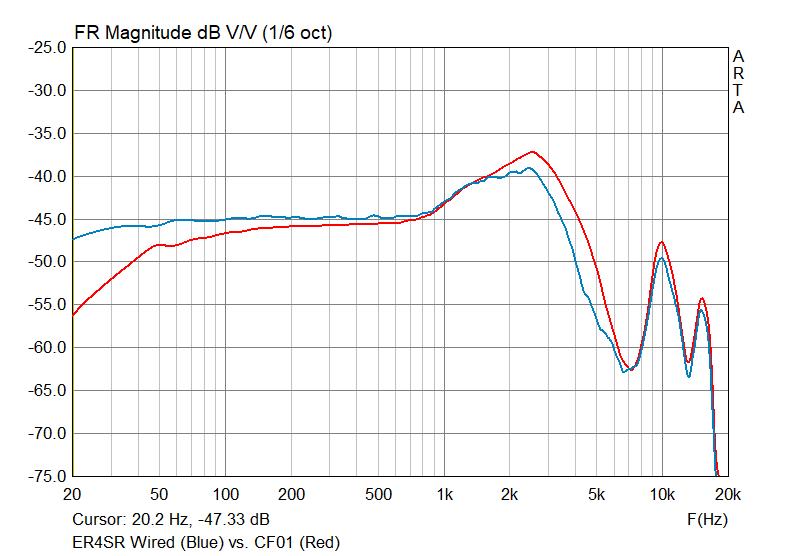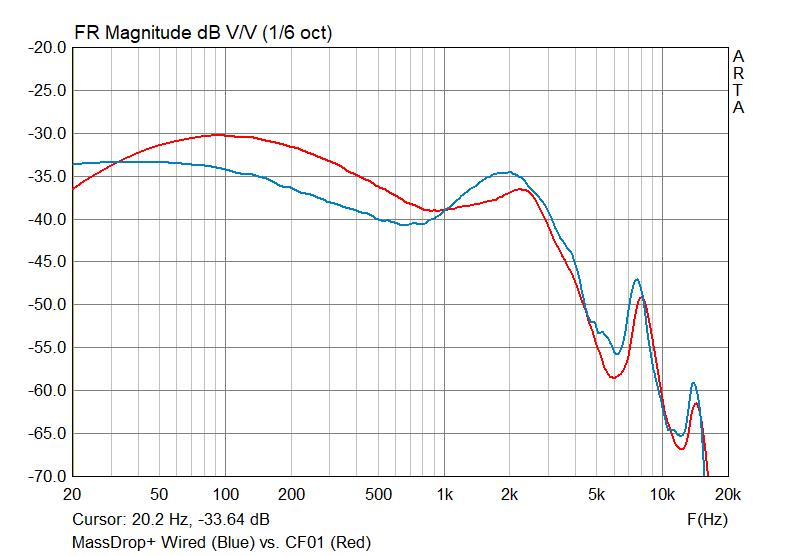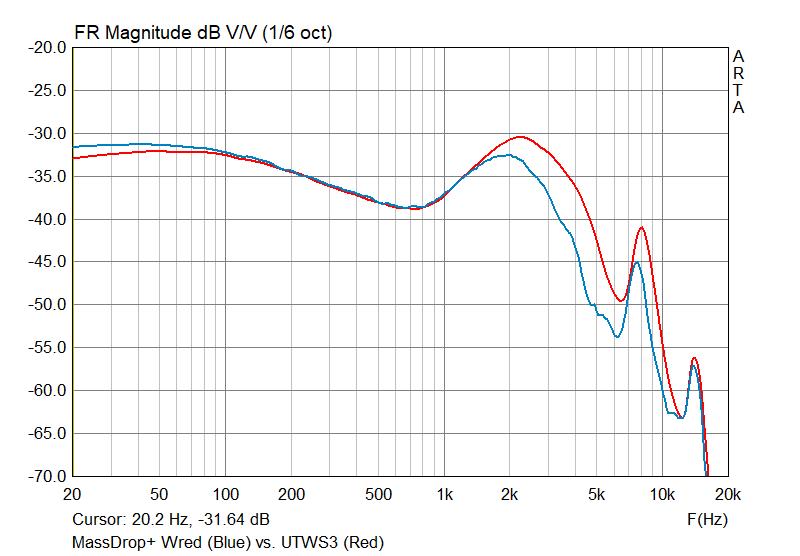Just measured my UTWS3 - output impedance is calculated at around 1.5 ohm or so, which is fairly respectable.
You are using an out of date browser. It may not display this or other websites correctly.
You should upgrade or use an alternative browser.
You should upgrade or use an alternative browser.
The TWS + Neckband + BT Cable Adapter Thread
- Thread starter ClieOS
- Start date
Just listened to my Massdrop Plus with UTWS3 and can confirm that I didn't hear any hiss at all. I used the same IEM for WS-1 but I can hear hiss. While there is no hiss with CF-01, the IEM sounds rather bad (due to CF-01 super high output impedance messing with the IEM crossover). To me, Massdrop Plus sounds the most 'correct' with UTWS3. This is definitely the best sounding TWS adapter in my collection now.
akarise
100+ Head-Fier
- Joined
- Feb 10, 2013
- Posts
- 431
- Likes
- 32
Could you perhaps compare the sound from the UTWS3 to the BTR3K? I would expect the BTR3K to sound better but I'm wondering whether or not the difference in sound quality is too big of a tradeoff for the convenience factor. I would be using them with the Meze Rai Penta btw.UTWS3 is here, first impression is very positive.
Could you perhaps compare the sound from the UTWS3 to the BTR3K? I would expect the BTR3K to sound better but I'm wondering whether or not the difference in sound quality is too big of a tradeoff for the convenience factor. I would be using them with the Meze Rai Penta btw.
There is a trade-off, but not nearly as big to the point that I'll opt for BTR3K instead of UTWS3. In fact, the opposite is kinda true as I tend t reach for UTWS3 most of the time. Note that UTWS3 is fairly close (though not quite equal) to BTR3K's single-ended (3.5mm socket) in term of output power, so it will drive most headphone that BTR3K can driver over single-ended. The only two area where UTWS3 can't compete are (1) BTR3K's balanced output power and (2) overall back ground hiss (*though to be fair, UTWS3 is probably one of the lowest hissing TWS adapter around)
I was meant to measure just how output impedance can affect FR curve, but never did find the time till now. So here are 4 examples Etymotic ER4SR (Single BA), Sony XBA-A3 (multi-drivers hybrid), FiiO FD5 (single dynamic) and MassDrop+ (multi-driver BA), measured with iBasso CF01 (20 ohm output impedance) and UTWS3 (around 1.5 ohm normally)
Source is FiiO M6 (both as wired as well as wireless BT source), measurement is repeated 4 times for each earphones and averaged. Graphs are all centered on 1kHz.








A few observations:
1) There are consistent elevation of FR on wireless BT measurement on mid to upper range, especially noticeable over 2kHz and 5kHz. This is regardless of whether it is CF01 or UTWS3 - that led me to conclude that this is most likely caused by aptX codec used by both CF01 and UTWS3.
2) Even for earphones that have a flatter impedance curve over its frequency range and less affected by output impedance of the source, you can still tell that the high output impedance of CF01 is causing roll off in bass.
3) With MassDrop+, which does affect by output impedance by a lot, you can see the CF01 almost completely changed its sound signature to something else.
Source is FiiO M6 (both as wired as well as wireless BT source), measurement is repeated 4 times for each earphones and averaged. Graphs are all centered on 1kHz.








A few observations:
1) There are consistent elevation of FR on wireless BT measurement on mid to upper range, especially noticeable over 2kHz and 5kHz. This is regardless of whether it is CF01 or UTWS3 - that led me to conclude that this is most likely caused by aptX codec used by both CF01 and UTWS3.
2) Even for earphones that have a flatter impedance curve over its frequency range and less affected by output impedance of the source, you can still tell that the high output impedance of CF01 is causing roll off in bass.
3) With MassDrop+, which does affect by output impedance by a lot, you can see the CF01 almost completely changed its sound signature to something else.
finally someone did this! thank you!I was meant to measure just how output impedance can affect FR curve, but never did find the time till now. So here are 4 examples Etymotic ER4SR (Single BA), Sony XBA-A3 (multi-drivers hybrid), FiiO FD5 (single dynamic) and MassDrop+ (multi-driver BA), measured with iBasso CF01 (20 ohm output impedance) and UTWS3 (around 1.5 ohm normally)
Source is FiiO M6 (both as wired as well as wireless BT source), measurement is repeated 4 times for each earphones and averaged. Graphs are all centered on 1kHz.
A few observations:
1) There are consistent elevation of FR on wireless BT measurement on mid to upper range, especially noticeable over 2kHz and 5kHz. This is regardless of whether it is CF01 or UTWS3 - that led me to conclude that this is most likely caused by aptX codec used by both CF01 and UTWS3.
2) Even for earphones that have a flatter impedance curve over its frequency range and less affected by output impedance of the source, you can still tell that the high output impedance of CF01 is causing roll off in bass.
3) With MassDrop+, which does affect by output impedance by a lot, you can see the CF01 almost completely changed its sound signature to something else.
out of curiosity, do you think the same change will apply with using AAC codec instead of AptX?
out of curiosity, do you think the same change will apply with using AAC codec instead of AptX?
No idea. However, AAC is known to be different by noticeable margin between manufacturers (*with Apple generally doing a better job) so there is likely going to be some difference.
FiiO Willson
Sponsor: FiiO
HiI was meant to measure just how output impedance can affect FR curve, but never did find the time till now. So here are 4 examples Etymotic ER4SR (Single BA), Sony XBA-A3 (multi-drivers hybrid), FiiO FD5 (single dynamic) and MassDrop+ (multi-driver BA), measured with iBasso CF01 (20 ohm output impedance) and UTWS3 (around 1.5 ohm normally)
Source is FiiO M6 (both as wired as well as wireless BT source), measurement is repeated 4 times for each earphones and averaged. Graphs are all centered on 1kHz.
A few observations:
1) There are consistent elevation of FR on wireless BT measurement on mid to upper range, especially noticeable over 2kHz and 5kHz. This is regardless of whether it is CF01 or UTWS3 - that led me to conclude that this is most likely caused by aptX codec used by both CF01 and UTWS3.
2) Even for earphones that have a flatter impedance curve over its frequency range and less affected by output impedance of the source, you can still tell that the high output impedance of CF01 is causing roll off in bass.
3) With MassDrop+, which does affect by output impedance by a lot, you can see the CF01 almost completely changed its sound signature to something else.
You are so professional, your spirit is worth learning from us




|
Stay updated on FiiO at their sponsor profile on Head-Fi.
|
Urnamaster13
New Head-Fier
TWS+ is required to be on the output device as well ? like my phone or a DAP. I have a Fiio M6 and was wondering if it can get an update to output audio signal via TWS+( which is Aptx TWS+ if i am not mistaken)
if anybody has used both UWTS3 and Shure Aonic adapter, let us know how they both compare...in terms of comfort etc.
if anybody has used both UWTS3 and Shure Aonic adapter, let us know how they both compare...in terms of comfort etc.
TWS+ will only be activated when both the source as well as the TWS adapter (*also applicable to TWS IEM) support it. Since TWS+ is an Qualcomm exclusive feature, it means the source as well as the TWS adapter needs to use Qualcomm chips. For the source, the SoC (= CPU) needs to be a more recent, higher end Qualcomm chip as older and lower end Qualcomm SoC don't support TWS+ mode. For TWS adapter, most Qualcomm QCC series of chips that can be used on TWS setup will supports TWS+ mode. All of Qualcomm QCC chips also support aptX, but it is unrelated to TWS+.TWS+ is required to be on the output device as well ? like my phone or a DAP. I have a Fiio M6 and was wondering if it can get an update to output audio signal via TWS+( which is Aptx TWS+ if i am not mistaken)
if anybody has used both UWTS3 and Shure Aonic adapter, let us know how they both compare...in terms of comfort etc.
Since FiiO M6 doesn't have a Qualcomm SoC at all, it can't support TWS+ but only normal TWS mode.
Urnamaster13
New Head-Fier
Thanks for your prompt and clear response.TWS+ will only be activated when both the source as well as the TWS adapter (*also applicable to TWS IEM) support it. Since TWS+ is an Qualcomm exclusive feature, it means the source as well as the TWS adapter needs to use Qualcomm chips. For the source, the SoC (= CPU) needs to be a more recent, higher end Qualcomm chip as older and lower end Qualcomm SoC don't support TWS+ mode. For TWS adapter, most Qualcomm QCC series of chips that can be used on TWS setup will supports TWS+ mode. All of Qualcomm QCC chips also support aptX, but it is unrelated to TWS+.
Since FiiO M6 doesn't have a Qualcomm SoC at all, it can't support TWS+ but only normal TWS mode.
One doubt, if Fiio M6 can have aptX codecs despite not having a Qualcomm SoC, can Fiio put TWS+ on it in future ? @FiiO Willson
also i am trying to find, in normal TWS is sound still using a master-slave method ? does it not play independently in both earbuds ?
In what way is TWS+ exactly beneficial compared to normal TWS ? is TWS/TWS+ only way to output send music via bluetooth on TWS type earbuds ?
it seems this codec is needed on smartwatches or small sized DAP also.
Thanks for your prompt and clear response.
One doubt, if Fiio M6 can have aptX codecs despite not having a Qualcomm SoC, can Fiio put TWS+ on it in future ? @FiiO Willson
also i am trying to find, in normal TWS is sound still using a master-slave method ? does it not play independently in both earbuds ?
In what way is TWS+ exactly beneficial compared to normal TWS ? is TWS/TWS+ only way to output send music via bluetooth on TWS type earbuds ?
it seems this codec is needed on smartwatches or small sized DAP also.
FiiO M6 has aptX because it runs a simplified version of Android (*though it is also very possible that M6 is using Qualcomm Bluetooth chip inside as Qualcomm is one of the biggest BT chip supplier around). aptX generally is fairly easy to implement on Android as it has very little hardware requirement and licensing from Qualcomm isn't very difficult to get. Basically any Android devices that uses an Qualcomm BT chip should have no problem getting aptX to work.
TWS+ on the other hand is a different story - Qualcomm is making TWS+ as a special feature on some of its higher-end SoC in order to push more manufacturer to use its SoC (and generally any manufacturer that use Qualcomm SoC will almost always going to use its BT chip as well) - so the situation is, if a devices has a Qualcoom SoC that supports TWS+, it will almost always has aptX as well. But if the devices has aptX, it however doesn't means it can support TWS+ at all. These are two different features offered by two different components - aptX by BT chips and TWS+ by SoC.
----
Yes, normal TWS configuration is a master-slave setup, where both left and right audio channel are transmitted via a single BT wireless channel to the master side first (*while the master side only playback one audio channel), then the master re-transmits the other channel to the slave side. TWS is less efficient because its needs to push two audio channel into one BT channel, then required another BT channel between master and slave side (*which will not be as easy since they are block by the human head). The master side will need to do a double duty. TWS+ is more efficient as two sides can operate independently using two BT channels and typically the connection will be stronger / more stable since the source will likely has a stronger connection to each side than the two sides between each other.
As for TWS+ vs. TWS - the main benefit is stability by a stronger BT connection. You won't get instant better SQ by going from TWS to TWS+. If you can get a stable TWS connection as much as you can get from TWS+, then you won't likely to notice any different when using the same BT codec
Remember, TWS+ is NOT a BT Codec. It is a special BT connection scheme that only certain Qualcomm SoC can support - so you can't just 'upgrade' to TWS+ if the device doesn't has any of those SoC. BT codec like aptX on the other hand is mostly software based and doesn't have as much restriction.
Last edited:
Urnamaster13
New Head-Fier
Thanks for clearing it up.
BTW Fiio M6 has an exynos 7270 SoC and SAMSUNG S5N5C10B01-6330 bluetooth chip.
I am looking for a TWS solution for pairing with my Shure earphones, at present it seems LDAC support is not possible. Might go for Fiio UTWS3 is i can find it.
BTW Fiio M6 has an exynos 7270 SoC and SAMSUNG S5N5C10B01-6330 bluetooth chip.
I am looking for a TWS solution for pairing with my Shure earphones, at present it seems LDAC support is not possible. Might go for Fiio UTWS3 is i can find it.
I have literally never seen a DAP with a chipset that will do TWS+. And I have been looking.
I have to assume that there are some phones out there with the appropriate SoC. There don’t seem to be many. I haven’t been looking for one, though, since I sold my soul to the ghost of Steve Jobs in a blood-fueled ritual.
But mostly, it seems like TWS+ is a feature that gets advertised on earphones with complete disregard for the fact that the required transmitter just doesn’t exist in the wild. It’s really kind of sad to think how many people out there are being tricked—just like I was—into thinking their earphones are doing anything to prevent the evils of the daisy-chained Bluetooth connection.
I have to assume that there are some phones out there with the appropriate SoC. There don’t seem to be many. I haven’t been looking for one, though, since I sold my soul to the ghost of Steve Jobs in a blood-fueled ritual.
But mostly, it seems like TWS+ is a feature that gets advertised on earphones with complete disregard for the fact that the required transmitter just doesn’t exist in the wild. It’s really kind of sad to think how many people out there are being tricked—just like I was—into thinking their earphones are doing anything to prevent the evils of the daisy-chained Bluetooth connection.
Barusu Lamperouge
Headphoneus Supremus
At times, it's even about SoC as most Qualcomm mid to premium range chipsets support TWS+ but the device manufacturers simply don't turn it on OOTB. Some do via OTA updates and some simply don't bother.I have literally never seen a DAP with a chipset that will do TWS+. And I have been looking.
I have to assume that there are some phones out there with the appropriate SoC. There don’t seem to be many. I haven’t been looking for one, though, since I sold my soul to the ghost of Steve Jobs in a blood-fueled ritual.
But mostly, it seems like TWS+ is a feature that gets advertised on earphones with complete disregard for the fact that the required transmitter just doesn’t exist in the wild. It’s really kind of sad to think how many people out there are being tricked—just like I was—into thinking their earphones are doing anything to prevent the evils of the daisy-chained Bluetooth connection.
Same goes for DAPs if they're using a Qualcomm SoC then they can enable it by default but probably don't due to reasons known to them.
Users who are viewing this thread
Total: 2 (members: 0, guests: 2)
























